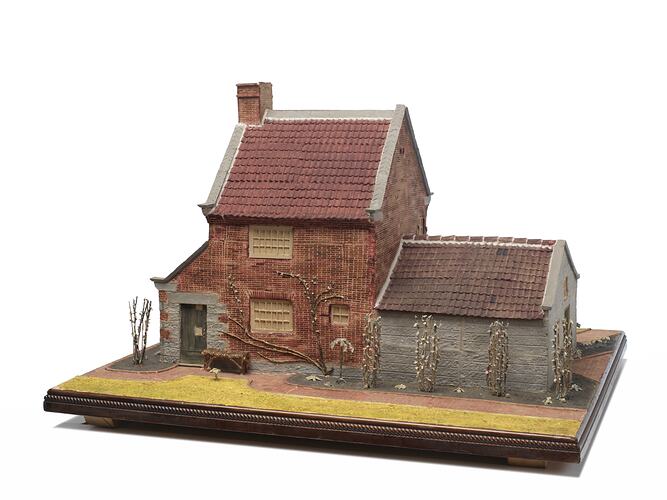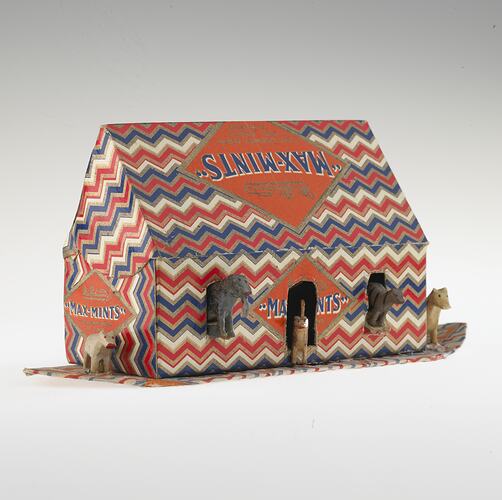Not what they seem: museum models made from unusual materials
A corked colosseum, sugar cottage and waxy wearables—these mini mega creations made from unusual materials need some special care.
Conservators are very good at slowing down time.
Ok, maybe not time itself but the inevitable result—ageing.
These magicians (as we like to think of them) can halt the march of time on objects and stop them falling apart.
Even when they do degrade, conservators are well-versed in putting things back together.
But some objects in the museum’s collection are so bizarre they need a little extra attention.
Corked
The cork model of the Roman Colosseum is one such subject made from an unusual material.
Even though it looks like it wasn’t made to last, it has had a surprisingly long life.
This particular example was made by London artist Richard Du Bourg, in 1775—nearly 250 years ago!
It is the only known survivor of the more than 40 models that Du Bourg built and displayed in his exhibitions between 1775 and 1819.
Cork models were very expensive souvenirs for well-heeled English tourists on their European Grand Tour—a rite of passage for young 18th century men.
Cork was an ideal material because it was plentiful, easy to shape and had just the right texture to replicate old ruins.
The Colosseum was selected to be part of the Mini Mega Model Museum exhibition in 2019.
But as the conservators discovered, time had not been kind to it.
It had changed hands many times since leaving Du Bourg’s collection and found its way to the museum in 1929.
Large chunks had fallen off, supporting walls were sagging, the base had warped and the whole model was in serious need of a clean.
‘When conserving unfamiliar materials, you have to think out of the box,’ says Sarah Babister, the conservator who took on the task of restoring the model.
‘In this case, testing adhesives and fill materials on wine corks and old cork sheets from entomology drawers before starting on the real-life repairs.’
After an extensive effort, as we’re sure you’ll agree, the result was a colossal success!
Error loading Partial View script (file: ~/Views/MacroPartials/MVInlineImage.cshtml)Iced
It sounds like something from a fairy tale, but the museum has a cottage entirely made from icing sugar.
In 1934, Cyril Noisette made a model of Cooks’ Cottage from icing to celebrate the Centenary of Melbourne.
Icing is quite an unusual material for model makers but Noisette had experience—he was employed as a cake decorator at MacRobertson's Confectionery Factory.
He was fastidious in his research, acquiring photos and details about the building and its surrounds.
Noisette’s model is an exact replica, even down to the plants planted around the cottage.
When the cottage was chosen for display in the Mini Mega Model Museum, it too was in need of some gentle restoration.
A few small details had come loose, and some holes needed filling, but the conservators are used to this kind of work.
The challenge is that everything needs to be reversible, so it can be returned to its original state and allow for future treatment.
In this case, any holes were lined with Japanese tissue paper and the icing fragments replaced by adhering them to the tissue using special acrylic glue.
A deep hole was filled with balsa wood shaped to fit, and the icing fragments secured in place.
The icing cottage also had some spider webs on it—evidence of a possible infestation.
Ordinarily that would mean a trip to a -30 ˚C freezer to remove any pests, but the icing sugar doesn’t respond well to that kind of treatment.
Instead, the cottage was carefully sealed up in plastic for several months and closely checked for signs of hiding pests.
Thankfully, none were found, and the cottage continues as a sweet homage to a momentous occasion.
Waxed
Before you ask—no, you cannot eat these apples.
They may look delicious but they are completely inedible.
The museum has a large collection of wax fruit originally created as educational aids for agricultural study.
Some of them are nearly 150 years old, and haven’t aged a day!
Most of these are apples and they represent almost every conceivable variety—even some you’ve probably never heard of like Stayman Winesap or Cornish Aromatic.
In fact, the wax fruit collection holds many heritage varieties that no longer exist.
While wax is ordinarily used to preserve edible fruit and protect it from insects, in this case it is being used to preserve the history of the varieties themselves.
Wax is an ideal material because it replicates the texture and feel of real apples, in much the same way wax is used to make human figures.
Like the icing sugar model of Cooks’ Cottage, these fruit models cannot be frozen to kill off pests as the wax would contract and possibly crack.
However, as long as they are kept away from heat and carefully handled, wax fruit models are fairly low maintenance—if only all objects were so easy to preserve!
Even some other wax models, like the Queensland Fruit Fly, can be much more demanding.
Fruit Flies are the apple’s natural enemy but this one couldn’t even stand on its own six legs.
It was originally made by the museum’s model maker Ruth Adams in 1960 and has had a hard life.
Missing pieces had to be recreated and then painted to match the rest of the model.
But it has now been restored to its former buggy glory.
Wrapped
Paper can be very a very difficult material to preserve.
Fortunately, the maker of this doll-sized hat—Johanna Hillier—opted to craft it out of waxed confectionary wrappers.
An odd choice, yes, but in 1929 this was an innovative example of domestic craft during difficult times.
And it’s proved critical to this hat’s longevity, even if it was never intended.
Hillier made this and dozens of other toys for her grandchildren from the wrappings of Max Mints, including furnishings for a doll house.
They carry the slight marks of wear and tear that are to be expected from these kinds of materials, but otherwise they’ve been very easy to take care of.
They were pieces of advertising ephemera, designed to be used once and thrown away.
Instead, here it is nearly 90 years later, still with us in the shape of these charming toys!
Even though these models were never really made to last, they have survived over the years.
This is in spite of the materials they were made of, not because of it.
Ultimately, it is to do with their uniqueness—we humans love objects, we collect and treasure them.
The Cork Colosseum, Cooks’ icing sugar cottage, wax apples and sweet wrapper toys, were all kept because they appeal to our love of things.
It is also the stories they tell about who we are and where we’ve been, that have led to these objects becoming part of the museum’s collection.
Thankfully now they are, they’ll be around for many more years to come.
Curious to know more about objects in the museum's collection, big or small? Ask Us!


















